When we see a particularly bright object in the sky, we often find ourselves asking, what is it? Is it a star? Maybe it’s a planet? And if the object is moving across the sky, could it be a satellite? If so, what type?
Have you ever observed something incredibly bright in the sky, but were left wondering what exactly you were looking at?
Let’s explore the top 10 brightest objects in the sky. Maybe you will discover the object you saw among them!
- 1. The Sun
- 2. The Moon
- 3. “Iridiums”
- 4. The International Space Station
- 5. Venus
- 6. Jupiter
- 7. Mars
- 8. Mercury
- 9. Sirius
- 10. Canopus or Saturn
- 11. Short-term celestial phenomena
- 12 Summary
1. The Sun
The Sun is the most brilliant and unquestionably the most essential entity in the atmosphere. It is included in this enumeration simply because its exclusion would be impossible. The Earth is an extraordinarily comfortable and welcoming place due to the sunlight and warmth provided by the Sun. Have you ever contemplated that rivers and oceans, winds and clouds exist solely as a result of the Sun’s heat? The Sun sustains life on Earth itself.

The Sun is the most brilliant celestial body in the Earth’s atmosphere. Photo: yta2/flickr.com
Our luminary during daylight hours is incredibly luminous. It is not recommended to directly gaze at it during the day to prevent harm to your vision! The Sun, which is relatively safe, can be observed at sunrise or sunset when its radiance is diminished as it filters through the dense atmosphere.
2. The Moon
The Moon is the primary celestial object visible in the nocturnal sky. Throughout ancient times, it held a significant role akin to the Sun in the diurnal sky, aiding in timekeeping, calendar creation, and navigation for travelers.
The Moon’s luminosity fluctuates according to its phase of illumination. During a full moon, its radiance surpasses that of a crescent moon. The brilliance of a full moon tends to obscure faint stars and nebulous formations, while having minimal impact on astronomical observations.
The Moon’s brightness can be significantly reduced during sunrise and sunset. During these moments, the Moon’s appearance is frequently altered as a result of refraction. Even though we are accustomed to the Moon, it can appear quite extraordinary – for instance, the Moon’s crescent shape at sunrise, when only one “horn” is seen above the horizon, can resemble a distant glowing sail.
3. “Iridiums.”
Sometimes there is a star that shines very brightly, almost blindingly so. After a few seconds, its brilliance begins to fade and within half a minute, it disappears completely. If you observe carefully, you can witness the star slowly moving across the sky.
What I have just described is none other than a flash of light produced by one of the satellites belonging to the Low Earth Orbit Communications System called Iridium. This phenomenon occurs when sunlight reflects off the smooth surfaces of the satellites’ antennas. Sometimes, the flash is so intense that it can be seen even during the early twilight, when no other stars are visible. This has led to countless rumors about UFOs and mysterious lights in the sky.

A dazzling display of Iridium illuminates the Beijing sky. Photo: lifelens/spaceweather.com
4. The International Space Station
The International Space Station (known as ISS) holds the distinction of being the largest man-made structure in space. With its ability to orbit the Earth 18 times in a single day, the ISS is visible from almost any location on the planet.
At times, the ISS can be mistaken for a swiftly moving airplane; numerous websites, including NASA’s, offer the opportunity to determine the precise time the station will be visible in the sky above your city, along with information regarding its exact position and brightness. The station’s visibility and luminosity are contingent upon the distance from the observer’s location – the further away it is, the fainter it appears. Under exceptionally favorable conditions, the ISS shines brighter than Venus!

In the summer of 2018, the International Space Station (ISS) was spotted crossing the sky of Stockholm. This photo was taken by Peter Rosén.
The ISS has linear dimensions of approximately 100 meters, making it smaller than the Moon or Venus. However, it is much closer to us, and through a telescope, you can observe that the ISS has an elongated rice-like shape.
5. Venus
Venus is a significant and nearly unlimited source of UFO sightings. There is perhaps no celestial object that generates as much controversy as this planet. In the eastern sky, it is frequently mistaken for searchlights, and when it is positioned low on the horizon, it is often confused with flares and the lights of airplanes heading towards it.

In the evening sky, you can see Venus and the Moon together. The bright Venus is easily visible even during the early twilight. This remarkable sight was captured in a photo taken by Maria Teresa and Raffaello Lena.
Venus appears like a large white star with “rays” emanating from it. It is visible in the evenings for a few hours after sunset or in the mornings before sunrise. What sets Venus apart from the stars is its exceptional brightness. It shines much brighter than any other star and can even be seen in the daytime sky!
One notable characteristic of Venus is its steady and tranquil glow. Unlike the stars, it does not flicker or shimmer. Its radiance remains constant and serene.
6. Jupiter
Planet Jupiter is considerably brighter than the stars, similar to Venus. Unlike the twinkling and shaking stars on a frosty or windy night, both Venus and Jupiter shine steadily. These two planets share this similarity.
Jupiter has a yellowish white color and can be observed throughout the entire night, unlike Venus. The main distinction between these two planets is that despite its relative brightness, Jupiter is still significantly less brilliant than Venus.
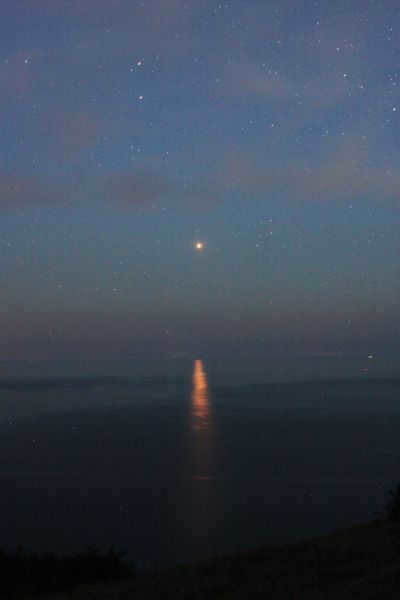
Mars was observed near the opposition on August 5, 2018. Photo: David Strange
Typically, Mars appears as bright as ordinary stars. However, every 2 years and 2 months, Mars comes closer to Earth, during which its brightness becomes similar to that of Jupiter. (During the occurrence of the great oppositions, Mars is even brighter than Jupiter, which occurs every 15-17 years).
During this period, Mars appears as a highly luminous star with a pinkish-red hue, positioned directly opposite the Sun in the sky.
8. Mercury
The planet closest to the Sun, Mercury, can be nearly as bright as Mars when it is in opposition. However, the challenge lies in locating Mercury in the sky. Being in close proximity to the Sun, it is often difficult to spot. In Russia, for example, it can only be observed during the evening or morning twilight.
Mercury doesn’t appear as stunning and mesmerizing against the relatively bright twilight sky as it does against a completely dark backdrop. Nighttime observations of Mercury are only possible in tropical and equatorial countries.
9. Sirius
Sirius is known as the most brilliant star in the night sky. It holds the ninth position on our celestial catalog. In Russia, Sirius can be observed in the sky from late summer until April, although the ideal time to gaze upon this stellar beauty is during the months of December through March. During winter, Sirius remains visible throughout the entire night.
Sirius stands out from other stars due to its exceptional brightness. One of its remarkable characteristics is that it frequently sparkles intensely and radiates in a myriad of hues, resembling the colors of a rainbow. Usually, all stars twinkle in the night sky when the atmosphere is turbulent, such as during freezing temperatures. However, Sirius twinkles with even greater intensity because it surpasses other stars in brightness and is situated low on the horizon.
If you happen to spot an extremely luminous star that appears low in the southern sky on a winter evening, twinkling and shimmering in a variety of colors, that celestial body is none other than Sirius!
10. Canopus or Saturn
I have divided the final slot on the list of the most luminous objects in the celestial sphere between two entities.
If one resides below the latitude of 37° north, it is feasible to observe the celestial body known as Canopus. Canopus. – the second most brilliant star in the nocturnal expanse following Sirius. Canopus acts as the leader of the Kiel constellation and formerly served as the most luminous star within the expansive constellation The ship Argo.. Indeed, this constellation derived its name from the vessel utilized by the Argonauts in their voyage to Colchis in pursuit of the Golden Fleece. During the 18th century, astronomers subdivided the Ship of Argo into the constellations of Stern, Keel, Sails, and Compass.
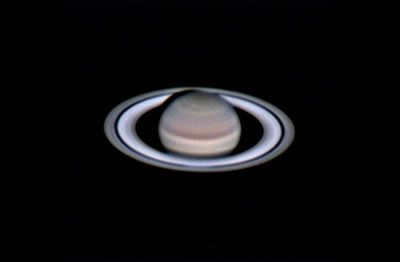
Saturn appears much brighter when its rings are fully expanded. Photo: Ed Lomeli/spaceweather.com
The planet Saturn is not easily visible from Russia, and the star Canopus cannot be seen at all. As a result, residents of Russia consider Saturn to be the 10th brightest celestial object.
Under normal circumstances, Saturn appears as a bright star. However, during perihelion, when its rings are fully expanded, the planet’s brightness significantly increases. During these periods, Saturn is only surpassed by Sirius in terms of its brilliance among all the stars.
Which items were not mentioned in the list?
First and foremost, bolides. Bolides are extremely luminous meteors, also known as “shooting stars.” Unlike man-made satellites, bolides are infrequently observed and only last for a few seconds. Additionally, they typically traverse the sky at a rapid pace.

The Chelyabinsk bolide. Source: Wikipedia
Meteors can shine as brightly as Jupiter, but bolides shine even brighter. The largest and therefore brightest bolides are much brighter than the full Moon! They do not completely burn up in the Earth’s atmosphere and instead reach the surface, becoming meteorites.
An example of a very bright bolide observed in the sky is the famous Chelyabinsk meteorite. The Chelyabinsk meteorite fell in February 2013.
Comets have the potential to be as brilliant as the Moon! A prime example of this is the near-solar comet Ikea-Seki (Ikea-Seki), which was observed in 1965. However, the most dazzling comets can only be seen during the morning or evening twilight, when the sky is still relatively bright. Additionally, comets are diffuse objects, causing their overall brightness to be spread out across a large portion of the sky, thus diminishing the impression of their brilliance. However, nothing can compare to the breathtaking beauty of a comet’s tail!
Another type of exceptionally bright celestial object is supernovae. Some historical supernovae were even brighter than Venus and could be observed with ease, even in daylight!
When an ancient star detonates, it typically gives rise to the extraordinary event known as a supernova. The brilliance of a supernova is directly proportional to its proximity to Earth. Alas, these cataclysmic explosions are exceedingly infrequent. In fact, the most recent recorded instance of a supernova in our galaxy occurred way back in 1604, during a time when telescopes had yet to be invented!
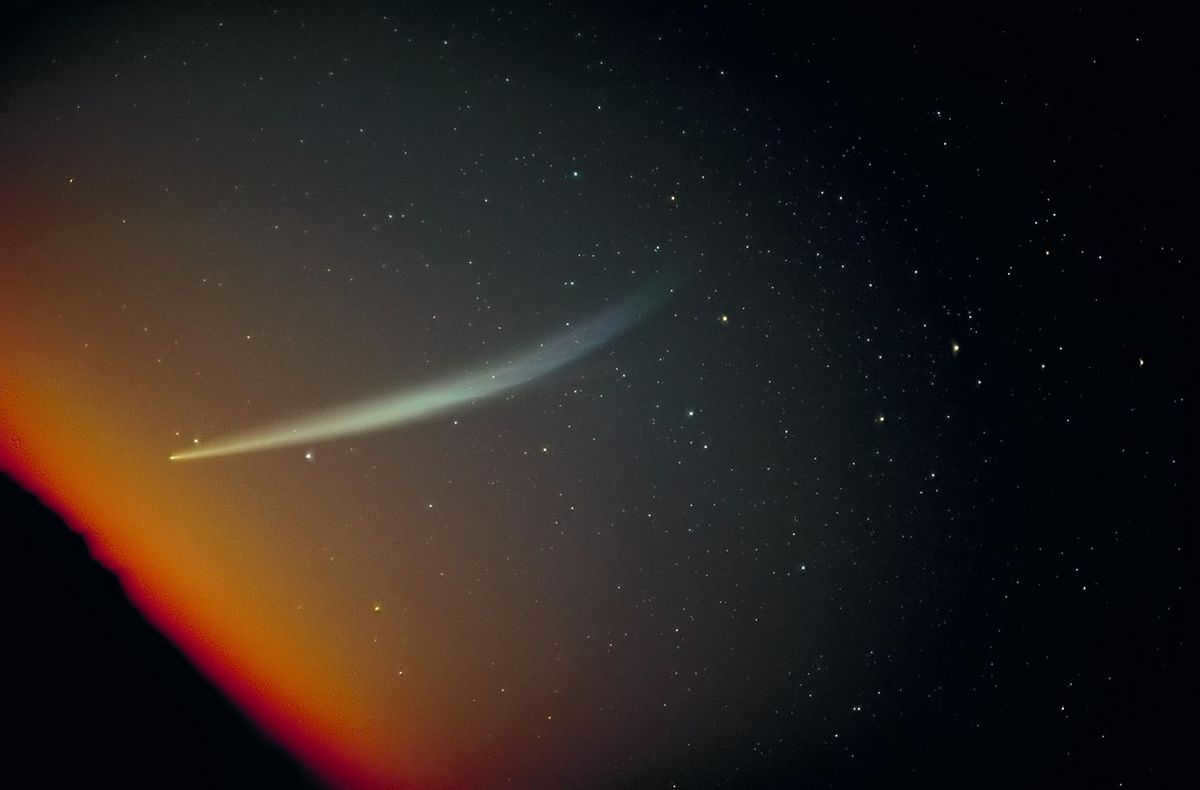
Comet Ikeya-Seki. Image: Wikipedia/Roger Lynds
In brief, the likelihood of observing a supernova explosion is exceedingly low. However, it is not impossible: for instance, Betelgeuse, located in the Orion constellation, has the potential to become such a star. Astronomers have identified additional potential candidates.
If you witness a fast-moving bright entity traversing the celestial expanse, it is highly likely that you are observing the International Space Station (ISS). Radiant Iridium flashes, while intensely luminous, endure for less than 10 seconds. Bolides, on the other hand, bear semblance to incandescent fireballs, often adorned with dazzling trails.
Immobile yet luminous entities occupying the heavens denote celestial bodies. Venus, for instance, is perceptible during the mornings and evenings. Jupiter and Mars, though observable both during the morning and evening hours as well as at night, never grace the heavens simultaneously. As these celestial entities ascend, it may deceive many into believing they are in motion. In reality, what you are witnessing is their ascent – Earth’s rotation causes the planets to ascend higher into the firmament.

The evening of June 16, 2018, offered a beautiful sight in the Nizhny Novgorod region – the moon and Venus shining brightly in the sky. The photo was captured by Vladimir Nerush.
During winter evenings, the night sky reveals the brilliance of Sirius, the brightest star. However, its position in the southern sky is not very high. Sirius is known to shimmer in various colors, resembling the hues of a rainbow (although not always!).
When it comes to brightness, the Sun, Moon, artificial satellites, and planets take the lead as the brightest objects in the sky. However, Sirius is not the brightest object to be seen. Planets, such as Venus, often change their brightness and are most visible during morning or evening twilight. Consequently, the brightest stars outshine them in terms of visibility.
Below is a table containing the most luminous celestial bodies and their corresponding star magnitudes.
| The Sun | -26.74 | while it illuminates the day |
| The Moon during its full phase | -12.9 | |
| An Iridium flash | -9.5 | at its maximum brightness |
| The International Space Station (ISS) | -5.9 | when the ISS is closest to Earth and fully lit by the Sun |
| Venus | -4.92 | at its brightest brilliance |
| Jupiter | -2.94 | during its peak luminosity |
| Mars | -2.94 | during its greatest oppositions |
| Mercury | -2.48 | near its conjunction with the Sun |
| Sirius | -1.46 | the brightest star visible in the night sky |
| Canopus | -0.72 | the second brightest star in the night sky |
| Saturn | -0.55 | at its closest point to the Sun and with its rings fully open |
A star is a luminous celestial object. This sets it apart from planets, comets, satellites, and nebulae, which receive their illumination from the Sun or other neighboring stars.
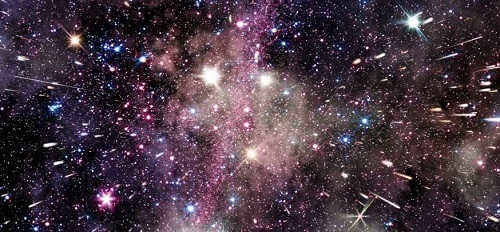
The surface temperature of this massive celestial body reaches a staggering one hundred and fifty thousand degrees Celsius. (We are referring to the surface of a white dwarf that has undergone formation).
How do astronomers gain knowledge about these heavenly entities?
By making observations, astronomers initially determine the surface mass, radius, and temperature. Although the interior of stars is not visible, it is known that they consist of plasma. The temperature is measured by analyzing the radiation emitted from the surface of the celestial object. Since photons cannot escape from the inside of stars, we do not have a direct view of their interiors. However, humans are able to accurately calculate the temperature at any point within these cosmic bodies. For instance, the temperature in the core of the Sun reaches thirteen million degrees. The highest-mass stars have interior temperatures exceeding three billion degrees.
Dimensions
The sizes of stars in the night sky can vary greatly. While white dwarfs have the same physical size as Earth, they are approximately a million times more dense. The tiniest stars ever observed are neutron stars, which are one hundred million times smaller in volume than Earth. Despite their small size, neutron stars possess an enormous mass, comparable to that of an ordinary neutron. These objects consist solely of neutrons and are known as pulsars. Pulsars are observed as pulsating sources of radio waves and can have masses several times that of the Sun.
Evolution vs. Progress
The development of a star is a slow rise in the heat within its core. The process of evolution commences with a dense gas-dust nebula globule, which experiences a gradual increase in temperature and could eventually reach a core consisting of iron with a temperature of 3.5 billion. At this point, gravity takes over and compresses the globule into a protostar, marking the final phase of its formation.
Weight
If the mass of a star is below 0.08 MQ (where MQ is the mass of the Sun), the temperature within the star is insufficient to sustain hydrogen fusion. For instance, a celestial object weighing 0.06 MQ is only heated to a temperature of 2.5 million degrees by gravitational forces, which is inadequate to convert hydrogen into helium. Such a gas ball can only survive through gravitational forces. Its predominant radiation spectrum is infrared. Once the star stops being compressed by gravity (becoming fully degenerate matter), it loses its energy source. Consequently, the ball cools down and transforms into a black dwarf. If the mass falls between 0.08 MQ and 4.0 MQ, the nebula becomes a light star. Our Sun is part of the light yellow dwarf star group. The temperature within can reach several hundred million degrees, meaning that thermonuclear reactions do not occur. The heavier stars within this group (ranging from 1.4 MQ to 4.0 MQ) are known as red giants. Throughout their lifespan, especially in their later stages, they expel most of their plasma into interstellar space. The result of this final plasma ejection is a planetary nebula.
The Red Giant consists of a massive degenerate core with a diameter similar to that of Earth, along with a vast convective zone plasma globule. A globule or gas-dust nebula with distinct boundaries and high density, weighing between 4.0 MQ and 8.0 MQ, evolves into a massive star with a core heated to over three billion degrees.
Based on the studies conducted by astronomers, it is estimated that there are more than one million pulsars present in our Galaxy.
Up until now, we have exclusively discussed the nucleus, which, when it collapses, transforms into a neutron pulsar. The shell layers, which lose their support, end up positioned a hundred thousand kilometers above the neutron star, but this occurrence lasts only a few seconds. Within the immensely powerful gravitational field of the neutron star, the shell layers of the red giant plummet like a colossal cascading waterfall towards the surface. As they descend onto the neutron sphere, the hydrogen-rich plasma from the giant’s shell becomes intensely heated, resulting in various thermonuclear reactions that transpire in an astonishingly brief timeframe. Essentially, we are describing an exceptionally enormous “hydrogen bomb” that scatters all of the plasma into the surrounding interstellar expanse. The ensuing explosion, known as a supernova, is so monumental that the shell layers dispersed around the neutron pulsar can still be observed centuries later. An example of this is the supernova in the Taurus constellation. The light emitted from this process reached Earth and was documented by Chinese and Arab astronomers in 1054. It has since been determined that the neutron star not only pulsates in the radio wave spectrum, but also in the visible infrared spectrum, the X-ray spectrum, and it emits cosmic gamma radiation. The expanding plasma from this supernova forms a nebula that has been dubbed the Crab Nebula. Presently, the “Crab Nebula” can be easily seen as an elongated spot through binoculars. Consequently, stars in the sky serve as celestial luminaries with diverse “extraterrestrial” characteristics and properties.

When we gaze up at the vast expanse of a cloudless night sky, we are inevitably greeted by a multitude of sparkling stars. Remarkably, hidden among this celestial tapestry are both celestial giants and diminutive dwarfs, each possessing their own unique characteristics in terms of temperature, color, age, and composition. Furthermore, these stars vary greatly in mass, resulting in their diverse and fascinating life cycles. Even in death, these celestial entities do not simply vanish into obscurity; instead, they transform into other celestial bodies, each possessing its own intriguing and extraordinary properties.

In an ever-evolving world, simply learning what is taught in school is no longer sufficient. It is crucial to acquire valuable knowledge about finance and investments to secure one’s financial well-being.
Take charge of your future and gain a comprehensive understanding of financial literacy through our online FINANCIAL LITERACY program.

Join us today, APPLY FOR YOUR ACHIEVEMENT
Distinctive Features of Stars
Stars are enormous spheres of luminous molten plasma. These celestial objects are created through the gravitational contraction of gas and debris clouds. As time passes, the central region of these formations becomes denser and hotter. Eventually, when the temperature of the core reaches 10 million degrees, thermonuclear reactions are ignited within it, causing the gas sphere itself to emit radiant energy and warmth.
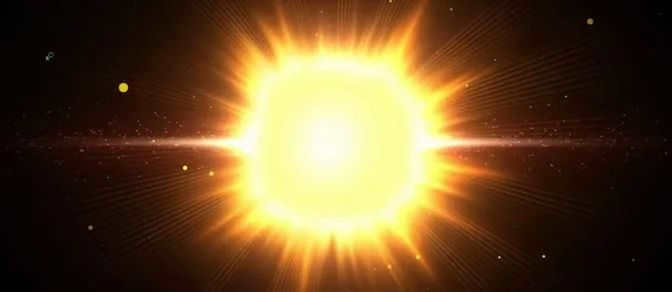
Luminosity
The primary source of energy for most luminaries (including the Sun) is the hydrogen cycle, also known as the proton-proton chain. This process involves a series of thermonuclear reactions that convert hydrogen into helium without the need for catalysts.
In ancient times, astronomers observed that stars vary in their brightness. Building upon this observation, Hipparchus, an astronomer from ancient Greece, created a catalog in the 2nd century B.C. This catalog included approximately 850 stars and provided accurate coordinates for each star. It was the first categorization of celestial stars, and Hipparchus introduced the concept of stellar magnitude.
The degree of brightness of a celestial luminary is known as stellar magnitude. It is measured in conventional units, and the object itself appears brighter as the value decreases. A change of one unit in magnitude corresponds to a change in brightness by a factor of 2.5.
Stars that have similar luminosity are grouped together. The most brilliant of these stars are referred to as first magnitude stars. Stars with slightly lower brightness are classified as second magnitude stars, and so on.
The scientist was convinced that all celestial bodies are positioned equidistant from the Earth, resulting in the disparity in brightness being solely dependent on the star’s size. As time passed, it was discovered that objects exist at varying distances from us. Consequently, a massive celestial body located far away from the solar system will appear diminutive and faint to an Earth observer when compared to a nearby luminous dwarf star. Despite this realization, modern astronomers still adhere to and actively employ the Hipparchus classification to this day. However, the contemporary interpretation of stellar magnitude pertains to the apparent brightness of a star and is no longer correlated to its physical dimensions.
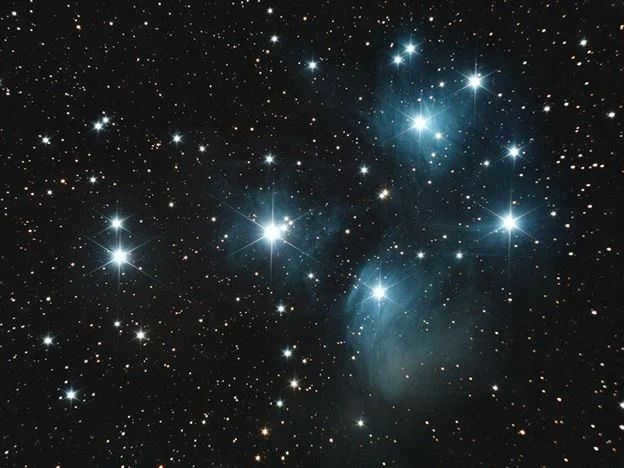
It is commonly acknowledged that the human eye has the capability to perceive celestial bodies with magnitudes ranging from 1 to 6 in the sky. However, stars with magnitudes of 5 to 6 can only be observed by individuals with exceptional eyesight, and even then, only under completely clear skies. Stars with a magnitude of 7 can be seen with standard theater binoculars, while field binoculars are required to observe stars with magnitudes of 8 to 9.
Modern telescopes have the capacity to detect stars with even fainter luminosity in the sky. These advanced instruments enable the study of stars with magnitudes up to 25 and beyond. Within the vast expanse of the Universe, there exist numerous immensely bright stars. In comparison, our Sun appears relatively dim. These stars are regarded as the most luminous in existence.
Scientists have made an important discovery in the field of stellar temperature determination. By analyzing the color of a star, they are now able to accurately gauge its temperature. More specifically, scientists study the spectrum of radiation emitted by the star to determine its temperature. It has been observed that blue stars are the hottest, with surface temperatures ranging from an average of 10,000 to 40,000 degrees Celsius. These stars possess an immense amount of energy, making them comparable to ultraviolet sources. Following blue stars are white stars, which have temperatures ranging from 7,500 to 10,000 degrees Celsius. Yellow and orange stars fall into the temperature range of 5,000 to 7,500 degrees Celsius. Finally, the coldest stars are red, with temperatures ranging from 2,500 to 5,000 degrees Celsius.
As we are aware, the core of a star is recognized as the most scorching region. It is within this core that all thermonuclear reactions occur, which in turn serve as the primary source of the star’s energy. Heat emanates from the central region of the star and ascends to the surface before ultimately radiating out into the vastness of space. Consequently, there can be a substantial disparity in temperatures between the core and the uppermost part of the star. Consider the Sun, for instance, where the core temperature reaches a scorching +15 million degrees Celsius, whereas the surface temperature is a relatively cooler +6 thousand degrees Celsius. Each celestial body possesses a stellar corona, which represents the outermost layer of its atmosphere. The temperature within this corona exceeds that of the star’s surface by a significant margin. In the case of the Sun, the corona temperature reaches an astounding +900,000-1,000,000 degrees Celsius. Scientists have yet to provide a definitive explanation for this drastic temperature surge, although it is likely attributed to the presence of magnetic fields.
Within the vast expanse of the Universe, there exists an abundance of stars akin to our very own Sun. These celestial bodies emit temperatures that are characteristic of numerous observable luminaries. However, interspersed throughout the cosmos, one can find stars that surpass the Sun’s heat. These extraordinary entities are known as blue supergiants. Some of them possess surface temperatures that soar to a staggering +200 thousand 0 C. Yet, this measurement merely pertains to the exterior. One can scarcely fathom the scorching temperatures that the stellar core can achieve. According to scientific findings, the core can reach temperatures in the hundreds of millions of 0 C.
Chemical composition
When examining the chemical makeup of stars, it becomes apparent that it closely resembles the composition of both the Sun and Earth. The majority of stars consist primarily of helium and hydrogen, which account for 99% of their mass. The remaining 1% is comprised of elements such as oxygen, carbon, iron, nitrogen, silicon, and magnesium. As temperatures decrease, it has been observed that the composition of stars also includes simpler compounds like titanium oxides, zirconium oxides, and radicals.

Source
Occasionally, stars can be found in the vastness of the Universe that are predominantly composed of a specific element such as silicon, iron, manganese, or carbon. Scientists have also come across stars with peculiar chemical compositions. For instance, certain young luminous stars, known as red giants, have been found to contain unusually high levels of various heavy elements. One particular star stands out for its excessive amount of molybdenum.
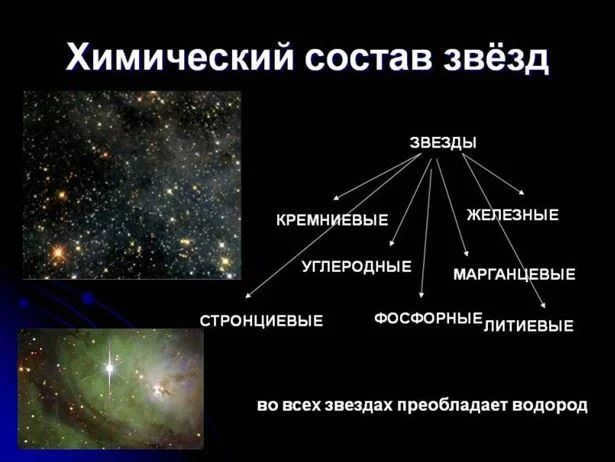
Source
The chemical makeup of stars is heavily influenced by their location within the galaxy. Older stars found in the spherical region of galactic space contain a lower concentration of heavy metal atoms compared to stars located in the spiral arms, which have a higher abundance of heavy elements. It is within these spiral arms that new stars are more likely to form. Based on this observation, scientists have deduced that the presence of heavy elements in a star’s chemical composition signifies the beginning of its lifecycle.
Let’s examine the alteration in the chemical makeup of stars by using the Sun as a prime example. With the passage of time, the quantity of helium in the central region of our Sun will progressively expand, resulting in an enlargement of the core’s volume. Consequently, the zone of thermonuclear reactions will also expand. Consequently, there will be an escalation in temperatures and luminosity. After the lapse of 1 billion years (when the Sun’s age will be 5.6 billion years), the energy increase will amount to 10%. When the Sun reaches an age of 8 billion years, its radiation will be 140% of its present level. During this interval, the conditions on Earth will undergo such profound changes that our planet will come to resemble Venus.
As the proton-proton reactions speed up, the composition of the star will start to change more actively. The rate of hydrogen combustion will increase, leading to an imbalance between the solar envelope and its core. The hydrogen shell will expand further, while the size of the helium core will decrease.
About 1 billion years from now, the Sun’s chemical composition will undergo its first significant changes. The core will experience a significant temperature rise and compression, triggering the next stage of the thermonuclear reaction, which involves helium combustion. As a result, the Sun will flare up 5,200 times more intensely than it does presently.
During the entire period, the core of the star will keep on heating up, while its outer shell will cool down significantly, extending all the way to Earth’s orbit. Additionally, the star’s mass will start to diminish. As a result of the stellar wind, hydrogen, helium, and other elements will be carried away into outer space. Eventually, the Sun will transform into a red giant. The final stage of the Sun’s existence will occur once its outer shell is completely depleted, leaving behind a compact and dense core known as a white dwarf. Over the course of billions of years, this core will gradually lose its heat.
The diversity of stars in terms of mass and size
Stars exhibit a wide range of sizes, just like their surface temperatures. Scientists employ various techniques to determine the size of individual stars. In the realm of science, there are both giant stars and dwarf stars. Each celestial body possesses its own mass, which directly influences its lifespan. Bodies with substantial mass are known for their unpredictability. In terms of cosmic standards, their life cycle is relatively short, lasting only a few million years, after which they can undergo sudden explosions, giving rise to supernovae. These dramatic transformations can lead to cosmic catastrophes.
By determining the mass of a star, scientists can track its evolutionary trajectory. Moreover, the mass of a star also impacts its temperature.
To calculate the mass of a star, scientists observe the movements of stars that exist in clusters or are part of binary systems. In these systems, objects are drawn towards each other and orbit around a shared center of mass. The law of universal gravitation is employed to determine the star’s mass, which is measured in units equivalent to the mass of the Sun, approximately 2*10 30 kg. The masses of different stars can range from 0.1 to 60 times the mass of our Sun.

Stars can be characterized by comparing their size, which scientists determine through the use of optical instruments and calculations. These methods have revealed that stars can range in size from hundreds of thousands to millions of kilometers. For instance, the diameter of our own Sun measures 1,392,000 km, and yet it is not even considered one of the largest stars in the Universe. On the other end of the spectrum, there are also stars that are very small in size, such as neutron stars, which have diameters of only 10-20 kilometers. Among the largest stars are Betelgeuse, Arcturus, and Antares.
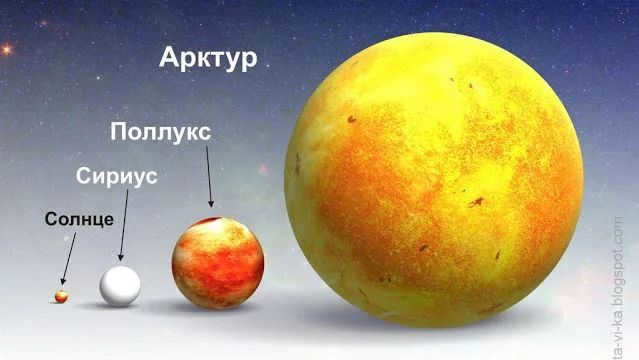
Source
Stars can vary in size more than in mass. The larger a star is, the lower its density of matter will be, and vice versa. Giant stars can have a matter density that is an order of magnitude less than the density of air on Earth. For comparison, the Sun has a matter density that is 1.4 times that of water. White dwarfs, on the other hand, are much denser than our star. For example, 1 cm3 of matter from the star Sirius weighs 50 kg. And this is not even the highest value. Neutron stars are considered to be the most dense, with a density of 1014 g/cm3. To achieve this density, the Earth would need to be compressed to a diameter of half a kilometer.
Counting Stars and Measuring their Distance
Thus far, no researcher has been able to accurately determine the exact number of stars in the sky. The information available is only an approximation. When observing with the naked eye, we can see a considerable number of stars – approximately 6000 celestial bodies. It is important to note that some of these stars are only visible in the Northern Hemisphere, while others can only be seen in the Southern Hemisphere. However, with the use of advanced telescopes, scientists are able to count stars in the billions and trillions.
While scientists have only counted stars that are visible to the naked eye or through a telescope, these celestial bodies have been recorded in specialized star catalogs. These catalogs include the star’s name, coordinates, description of its motion peculiarities, and temperature. Additionally, information such as class, stellar magnitude, size, density, luminosity level, and distance from the Solar System can be found. The earliest star catalogs date back to around 5000-6000 years ago, with one of the oldest compiled by the ancient Greek astronomer Hipparchus in 136 BC. Hipparchus listed 850 stars that could be seen without the aid of any instruments. 200 years later, Claudius Ptolemy supplemented Hipparchus’ catalog, adding 1022 stars and providing coordinates with high accuracy. Remarkably, Ptolemy’s work remained a valuable resource for scientists for over 1500 years.
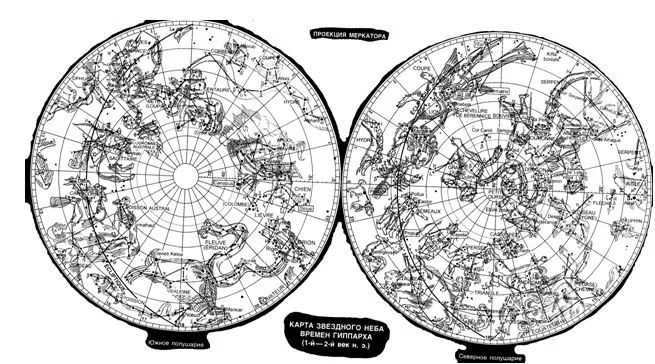
Jan Hevelius, who lived from 1611 to 1687, published a star atlas in 1690 that contained an impressive count of 1564 stars. Some of these stars were discovered by Hevelius himself using a telescope, which allowed scientists to gain a deeper understanding of the vastness of outer space.
Nowadays, modern star catalogs not only include a vast number of ordinary stars, but also other celestial objects such as variable stars, double stars, new stars, supernovae stars, comets, asteroids, and black holes. These catalogs are constantly updated and refined as new data becomes available, ensuring that our knowledge of the universe continues to expand.

The vastness of the interstellar space is such that the light emitted by a star takes several decades to travel from one star to another. In the field of astronomy, the magnitude of these distances is measured using the unit of a light year, which is equivalent to approximately 9,460 million kilometers. It is fascinating to consider that stars that appear to be in close proximity to each other in the night sky are actually separated by several light years. Furthermore, the distance between two stars that are considerably distant from each other can be calculated to be anywhere from tens to millions of light years.
Star clusters and nebulae
As it is commonly known, stars are not evenly distributed throughout the sky. In certain regions of the Universe, they are closely situated, and these areas, due to their high luminosity, are easily visible from long distances. In other regions, however, the stars are more spread out, appearing as solitary sparks against the backdrop of the night sky. What we perceive as a dense scattering of shining lights is referred to as star clusters. In simpler terms, they are groups of stars that are held together by the force of gravity. All objects within such a cosmic community share a common origin and have similar chemical compositions.
Scientists classify star clusters into two distinct types:
Typically, globular star clusters consist of tens to hundreds of thousands of stars. These clusters are known for their nearly perfect spherical shape, with stars arranged in an orderly fashion, almost as if following a precise blueprint.
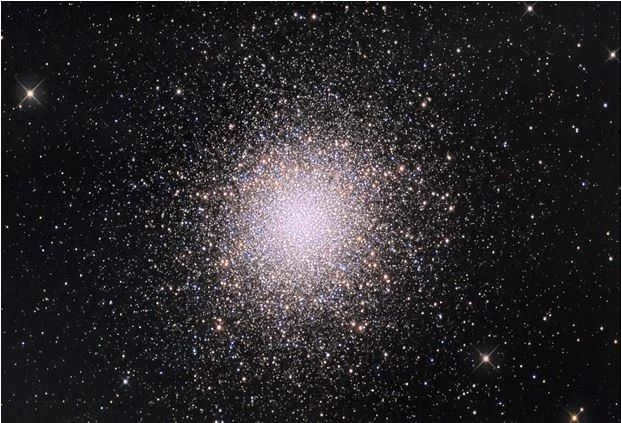
The oldest objects in the galaxy are globular star clusters, which do not contain any giant stars, known as the youngest luminaries. This suggests that globular clusters were formed shortly after the Big Bang. Interestingly, the concentration of these objects increases as you move towards the center of the galaxy.
There is another unexplained characteristic of globular star clusters – they are all located symmetrically in relation to the galactic center. Most of them can be found towards the constellation of Sagittarius, which is where the center of our Galaxy is situated.
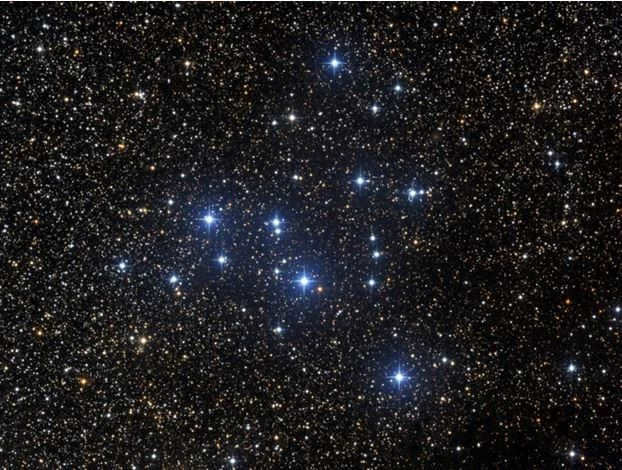
The Stozhary, also known as the Pleiades star cluster, is a renowned diffuse cluster of stars located in the Taurus constellation. When observed with the naked eye, one can distinguish 7-8 stars that are in close proximity to each other. However, when viewed through a telescope, over 150 stars can be seen in a small area. The most prominent star in the Pleiades cluster is Alcyone. This cluster is unique in that its stars form a distinct system, connected by their common motion through space. The diameter of the Pleiades cluster is approximately 50 light-years.
In the Taurus constellation, which surrounds the main and brightest reddish giant star Aldebaran, there is another star cluster called the Hyades. This cluster appears more diffuse in comparison.
Currently, the most fascinating celestial entities for astronomers are known as star associations. These are referred to as the youngest formations within our Galaxy, consisting of clusters of youthful stars that are no more than 10-20 million years old. Typically, stellar associations encompass groups of specific types of luminous bodies that share a common origin.
Nebulae are relatively large, dimly glowing patches of gas and dust that add a touch of beauty to the vastness of space.
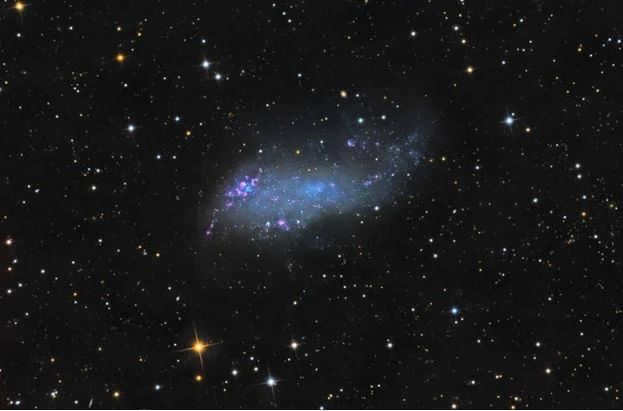
Typically, these regions in the cosmos are categorized as galactic nebulae. This term refers to clouds of rarefied gases and dust that exist within galaxies. Among these nebulae, there are two main types:
Spheroidal planetary formations have distinct shapes, often appearing as round or oval disks similar to planets (or their rings) when observed through a telescope. On average, they have a diameter of about 10,000 astronomical units.
At the core of each of these entities resides an invariably scorching celestial body. This celestial body serves as the genesis of the nebula’s radiance, with its temperature often scaling heights of 70,000 – 150,000 degrees Celsius. The tenuous gas comprising this “spot” disperses in diverse trajectories, propelled away from the celestial body at velocities of tens of kilometers per second. On certain occasions, planetary nebulae may deviate from their spherical form and adopt the shape of a ring. This peculiar transformation transpires when the gaseous envelope encasing the celestial body possesses an internal cavity.
Some nebulae lack a defined shape. They resemble wisps of dense fog, leisurely spreading in various directions. These are known as diffuse formations. These objects are also composed of rarefied gases that emit light when exposed to the radiation from hot stars at their center. In general, all gas nebulae emit light by converting short-wave (ultraviolet) radiation from very hot stars, which are either located within the nebula itself or in close proximity.
Aside from gas nebulae, there are numerous other nebulae present in the Universe. These are not formed by gas particles, but rather by a cluster of dust particles, which are comparable in size to ordinary smoke particles. Consequently, these formations are referred to as dusty galactic nebulae. They are categorized as diffuse objects and can appear either bright or dark.
Occasionally, a star encounters a cloud, causing it to temporarily disappear from the view of a distant observer. The particles within the cosmic dust rapidly heat up, resulting in the entire cloud emitting a faint glow. These luminous nebulae, which reflect the light from nearby stars, are exceptionally beautiful occurrences, although they are not very common.
However, not all dust clouds come into close proximity with stars. In many cases, these objects are of the dark variety. When there is no nearby cosmic body capable of illuminating the dust, it forms dark clouds with well-defined edges. These dark dust clouds are most prevalent in the bright regions of the Milky Way or in the backdrop of luminous galactic nebulae.
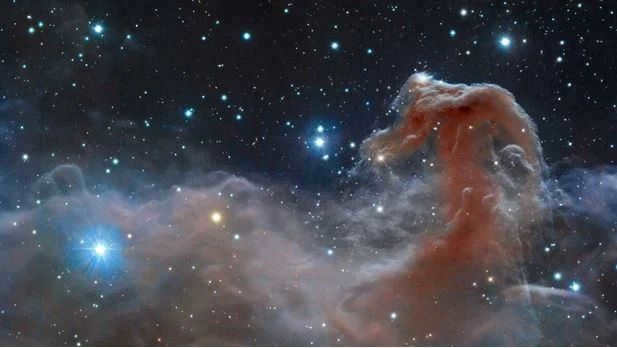
An illustration of a planetary nebula is the Snail Nebula, which emerged roughly 10,000 years ago as a result of the substance from the external layers of an exploding newborn star.
The Andromeda Nebula is renowned and extensively examined by researchers. It is the solitary galaxy that is barely visible to the naked eye.
The investigation of stars persists year after year. Scientists uncover novel celestial objects, refine existing evidence, and carry out fresh calculations. Not too long ago, it was detected that there are planets encircling certain stars, on which it may be possible to identify signs of life in the future.

Stars are captivating and enigmatic entities in our vast cosmos. They flicker on the expanse of the celestial dome, captivating the gazes of individuals. In this piece, we will examine the factors behind the radiance of stars and delve into their significance in our existence.
What is a star?
Before we delve into the reasons behind the luminosity of stars, let’s establish the definition of stars themselves. A star is an immense amalgamation of gas, primarily comprised of hydrogen and helium. Through the process of nuclear fusion, hydrogen undergoes a transformation into helium, releasing an immense amount of energy, which we perceive as light. This phenomenon is universal among all stars, including our very own Sun.
Stars come in various sizes and hues, predominantly influenced by their mass and temperature. Moreover, stars experience diverse stages throughout their lifespan, commencing with their formation from a molecular cloud, progressing through an extensive “main sequence” phase, and culminating in disparate outcomes depending on their mass: certain stars evolve into white dwarfs, while others transform into neutron stars or black holes.
Stars play a crucial role in the Universe as they serve as the primary source of light and heat for the planets that revolve around them, as well as the birthplace of the essential elements required for life.
What causes stars to emit light?
Nuclear fusion
The emission of light by stars is a result of nuclear fusion. Within the core of a star, thermonuclear reactions occur, converting hydrogen atoms into helium atoms. This process releases tremendous amounts of energy in the form of light and heat.
The journey of a star
Stars experience various phases throughout their lifespan. Starting from their formation within massive molecular clouds to their eventual demise and decomposition. Throughout each of these phases, stars emit both light and heat.
The correlation between a star’s temperature and color
A star’s color is determined by its temperature. Stars with high temperatures emit a blue or white glow, while stars with lower temperatures emit a red or orange glow.

Stars in the night sky
Factors affecting the visibility of stars in the sky
When we gaze up at the nocturnal sky, we are greeted by a multitude of stars of various luminosities and sizes. The visibility of these stars is influenced by several key factors:
- Light pollution: Urban areas produce copious amounts of artificial light that can mask the natural radiance of the stars. This phenomenon is commonly referred to as light pollution. In contrast, away from the glare of city lights, stars can be observed with much greater clarity.
- Atmospheric conditions: The presence of clouds, fog, smoke, or dust can obstruct the visibility of stars. The lower the humidity and pollution levels in the air, the more clearly the stars can be discerned.
- Time of day and year: Stars are only visible during the night when the Sun’s luminosity does not overpower their own. Furthermore, different constellations become visible at different times of the year due to the Earth’s orbit around the Sun.
- Depending on where you are on Earth, you will observe different stars as their visibility is influenced by your latitude.
- Stars have varying levels of brightness, with some being bright enough to be seen even in areas with high light pollution, while others are much dimmer and require optimal conditions to be visible.
- The phase of the moon also plays a role in star visibility, with a full moon potentially obscuring the light from faint stars, while a new moon provides better conditions for star observation.
Distance and luminosity
The proximity of a star to Earth determines its luminosity. The distance to a star is a crucial factor in determining its visibility in the night sky.
Absolute versus apparent stellar magnitude
Absolute stellar magnitude measures the brightness of a star as it would appear from a distance of 10 parsecs from Earth (one parsec is equivalent to 31 trillion kilometers, or 206,265 astronomical units, or 3.259 light-years). On the other hand, apparent stellar magnitude measures the brightness of a star as perceived from Earth. A smaller value for the apparent stellar magnitude indicates a brighter star.
Stellar magnitude index
Within this particular system, stars are assigned numerical values known as their magnitudes. The smaller the numerical value, the more luminous the star appears. First magnitude stars are five times more luminous than second magnitude stars, which are, in turn, five times more luminous than third magnitude stars, and so on. This system enables astronomers to make comparisons between the luminosity of stars, regardless of their distance from Earth. According to this system, the most luminous objects in the sky, aside from the Sun, include Venus (with magnitudes as low as -4.6), the Moon (with magnitudes as low as -12.7), and the International Space Station (with magnitudes as low as -6).
Understanding Star Magnitudes and their Importance in Astronomy
Star magnitudes are a critical aspect of classifying and describing stars, playing a significant role in the study of the night sky and astronomy as a whole.
Stars as Crucial Navigational Points
Stars have served as vital navigational landmarks throughout history, even in ancient times. Sailors, for instance, relied on the stars to ascertain their location when there were no other landmarks to guide them on the vast seas.
One particularly renowned navigational landmark is Polaris, also known as the North Star, which is situated near the north celestial pole. It remains fixed in the sky, with its direction always indicating north (in the northern hemisphere of Earth), making it an exceptionally useful reference point for navigation.
As an illustration, in previous times, sailors used to search for the well-known constellation of the Big Dipper in order to locate Polaris. Specifically, two stars in the “bucket” of the Big Dipper (Merak and Dubhe) accurately point towards Polaris.
Another instance is provided by the constellations of the southern hemisphere, such as the Southern Cross, which served as significant navigational indicators for individuals residing in the southern hemisphere.
Despite the diminished significance of star navigation due to advancements in modern technology like GPS, it can still prove to be valuable in emergency scenarios.
Stars and the changing seasons
Stars are also connected to the changing seasons throughout the year. Certain stars can only be seen at specific times, which helps determine the current season.
Stars and navigation
Stars have historically played a crucial role in navigation in many societies. Sailors, explorers, and shepherds used the stars as guideposts to navigate and prevent getting lost.
Summary:
Stars are incredible celestial bodies in the vast expanse of the Universe, emitting light through the process of nuclear fusion. Their appearance in the night sky is influenced by their distance from Earth, their brightness, and their stellar magnitudes. Not only do stars serve as crucial navigational tools, but they also hold significant cultural and artistic significance. The enigmatic allure and captivating beauty of stars never fail to ignite our imagination and fascination.
Commonly Asked Questions
Stars emit light because of the process of nuclear fusion in their core, which involves the conversion of hydrogen into helium. This conversion releases a significant amount of energy in the form of light and heat.
Indeed, the light emitted by stars can change over time. For instance, towards the end of its lifespan, a star may undergo a supernova, causing it to shine much more brightly than usual for a period. Additionally, some stars are known as variable stars and experience changes in brightness due to internal processes or the presence of another object, such as a planet, passing in front of them.
The color of a star is determined by its temperature. Hot stars emit blue or white light, whereas cooler stars can emit yellow, orange, or even red light.
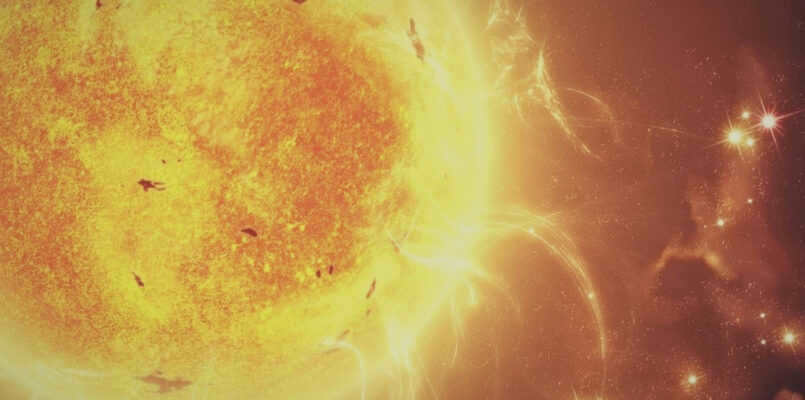
Astronomy
What is the nature of a star in the vastness of space? What are the factors that contribute to the creation of new stars and supernovae? How do stars change over time?
During a clear and cloudless night, we gaze upwards and witness an abundance of shimmering lights that appear to be embellishments on a somber canvas of the cosmos – an omnipresent darkness that seems to devour everything in its path!
These minuscule glimmers are known as stars. But what exactly is a star? How does it come into existence? What occurs when it vanishes? These are the most common inquiries that many of us have posed to our parents and educators. In this piece, we will explore these subjects and much more. Are you prepared? Let us commence…
Recall the sensation of gazing up at the night sky adorned with stars
What exactly is a star?
A star represents a massive sphere filled with gas. The gas contained within it is heated to such extreme temperatures that it emits light. A star is primarily composed of two elemental components, namely hydrogen and helium. One might wonder: “Given that a star is composed of gas, how is it possible for the gas to remain intact?“
That is indeed an excellent query. The explanation lies in the fact that the enormous size of the gas sphere causes its own gravitational force to hold the gas atoms together.
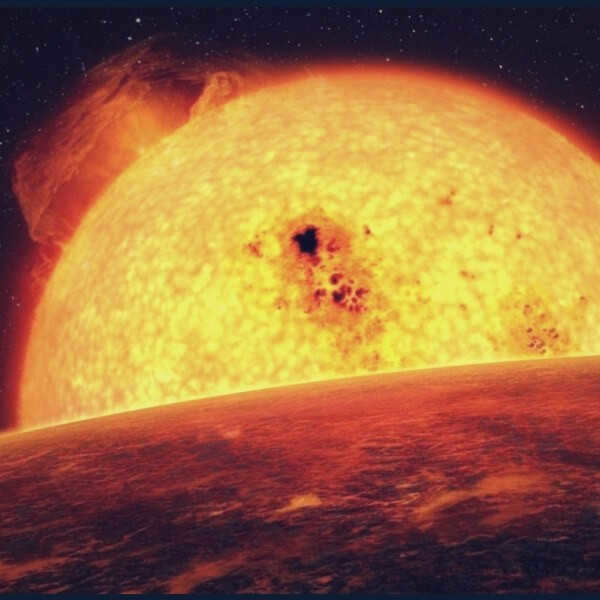
Now, there is another query that arises: "Why doesn’t gravity cause the star to compress towards its center if it holds the star’s shape together?"
Indeed, that is precisely what occurs. Within the sphere, gravity is so powerful that the gas atoms actively gravitate towards the center, resulting in a significant rise in temperature. This elevated temperature is responsible for triggering a nuclear reaction known as a "fusion reaction." During this process, elementary atoms merge to form heavier elements.
When fusion occurs, a tremendous amount of energy is released. This energy creates an outward pressure from the core, acting as a counterforce to the inward gravitational pull. This maintains the star’s stability and prevents it from collapsing under its own gravity.
The life cycle of a star
Every star follows a similar pattern of birth and demise. These stages include:
Now, let’s examine each stage individually to comprehend the star’s formation and its evolution throughout its lifespan.
Stage 1: Gas and dust cloud: the nebula
Gas and dust are scattered throughout the universe and can be found in nearly every galaxy. These particles remain in a relatively stable state, not actively participating in any significant processes.
However, the equilibrium of gas and dust can be disrupted by external factors such as a passing comet or a nearby supernova explosion. It is through these events that the formation of stars initiates.
The sudden gravitational disruption leads to the collision and cohesion of gases and dust, resulting in the formation of massive clouds known as nebulae.

A single nebula can extend over hundreds or thousands of light-years. These vast clouds are sometimes referred to as “stellar nurseries,” as they serve as the birthplace of stars.
Stage 2: Protostar (Star Birth).
Within the nebula, occasional turbulence occurs, leading to the formation of clumps consisting of significant amounts of gases and dust. These clumps, or knots, interact with each other through gravitational attraction. As this collapse continues, the material at the core gradually increases in temperature.
Phase 3: Main Sequence Star
At a certain point, the protostar reaches a critical temperature where hydrogen atoms start undergoing fusion to create helium atoms. This process is referred to as a “fusion reaction.”
When the fusion reaction commences, an immense amount of energy is released. The collapse of gas and dust persists until the energy released by the fusion reaction matches the gravitational attraction in the nucleus. This state is known as the “hydrostatic equilibrium state,” and the protostar transforms into what is commonly called a Main Sequence star.
“We have conquered outer space, but not our own inner world.”
George Carlin
What exactly occurs during the hydrostatic equilibrium stage?
The gravitational pull of the star’s core is countered by the outward ejection of energy from the fusion reaction, resulting in a balanced spherical shape. This marks the maturity phase of the star.
- A star can take millions of years to reach adulthood after the initial collapse. Our sun, for instance, took 50 million years to reach adulthood!
- Main sequence stars make up the majority of stars in the universe.
- Main sequence stars remain mature for an extended period of time, lasting billions of years. For example, our Sun will remain a Main Sequence star for a total of 10 billion years (4.5 of which have already passed).
- A star remains a Main Sequence star until it exhausts its fuel for nuclear fusion, which is the process of fusing hydrogen atoms into helium atoms. This means that as long as there are enough hydrogen atoms, the star will continue its adult life. Once the fuel runs out, the star enters the death phase.
- Typically, a star spends about 90% of its lifetime in the Main Sequence phase.
- The duration of the Main Sequence phase depends on the star’s size and temperature.
Phase 4: The Demise of the Star in Space
This is the point in the star’s journey where things become truly fascinating.
There is a general principle to keep in mind: the larger the star, the shorter its lifespan.
The star’s demise is marked by a stage in which all the core’s hydrogen is consumed and transformed into helium. Once the core has depleted its hydrogen supply, the nuclear fusion reaction ceases. The star no longer has the necessary fuel to sustain its existence. Hydrostatic equilibrium breaks down, causing the star’s core to collapse and its temperature to rise.
Simultaneously, outside the core, the star may still possess hydrogen. This means that fusion reactions can continue within the shell. The energy released from these reactions causes the shell to expand.
Simultaneously, the progressively hotter core will exert pressure on the outer layers, causing them to expand outwards. In the process of expansion, the shell will gradually lose heat. In due course, this celestial body will transform into what is commonly referred to as a red giant.
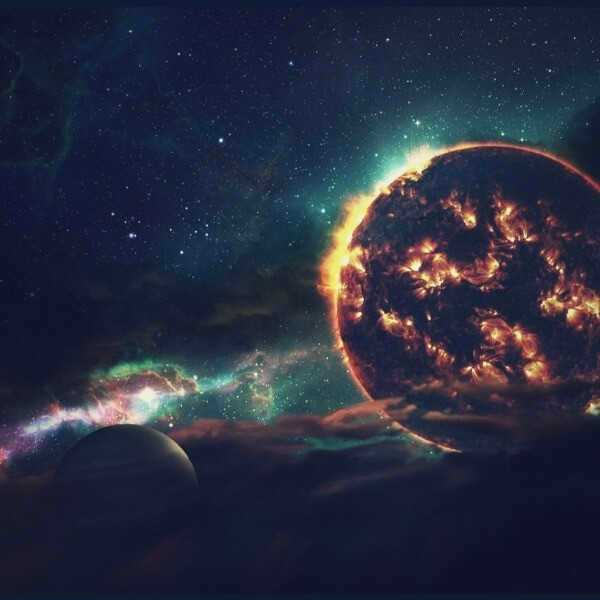
If a dying star is exceptionally massive, its collapsing core can be large enough to initiate additional nuclear fusion reactions. As a result, the helium within the collapsing core will merge together, ultimately forming heavier elements like iron.
Unfortunately, these extraordinary nuclear fusion reactions are inherently unstable. At times, the nucleus may burn up or extinguish entirely. This instability ultimately leads to the star pulsating. Consequently, the pulsating star sheds its expanded outer layer, creating a cocoon of dust and gas surrounding the core.
At this stage, the fate of the star hinges on the size of its core. From here on out, things only become more intriguing!
So, what might happen to the star in the future?
White dwarf stars
White dwarf stars are created from average stars that have masses roughly equivalent to our Sun. It’s worth noting that our Sun is considered an average star, and any star with 1.4 times the mass of our Sun would also be considered average.
Once these Main Sequence stars shed their outer layers through pulsations, their inner core becomes “exposed”. This core is extremely hot and is referred to as a White Dwarf.
White dwarfs have a similar size to our planet Earth, but they possess a much greater mass. This has long been a source of fascination for astronomers. They have pondered, “If a White Dwarf has such a significant mass, why doesn’t it collapse inward?”. The answer to this question is quite intriguing.
It appears that White Dwarfs are sustained from collapsing due to the presence of high-velocity electrons within them.
Below, you’ll find some intriguing details about these celestial objects:
- The core of a Main Sequence star increases in mass as the star grows larger. Consequently, the resulting White Dwarf becomes denser.
- A White Dwarf with a smaller diameter actually possesses more mass!
- Only stars of medium size have the potential to become White Dwarfs. This means that our Sun will transform into one eventually.
- If a star’s mass is 1.4 times greater than that of the Sun, it will not become a White Dwarf due to the inability of the high-velocity electrons in the nucleus to counteract gravitational collapse. These stars meet a different fate.
Brand new
Occasionally, a white dwarf might become a part of a binary star system or a system consisting of multiple stars. In such instances, there is a possibility that the white dwarf will be in close proximity to its companion stars. This close proximity might enable the white dwarf to gravitationally attract matter, predominantly hydrogen, from the outer layer of the companion star. As a result, an outer layer will form around the white dwarf itself.
If the white dwarf succeeds in accumulating enough matter, the fusion reaction within the white dwarf can reignite. Consequently, it will experience a sudden increase in brightness.
If a White Dwarf is sufficiently massive and formed from a star that is significantly larger than our Sun, it has the potential to accrete enough hydrogen to undergo gravitational collapse, resulting in an explosive event known as a Supernova. In the case of a less massive White Dwarf, however, it will instead experience a different phenomenon known as a Nova. During a Nova, fusion reactions occurring on the surface layer cause the White Dwarf to expand, eventually leading to the destruction of its outer shell in a powerful explosion. As the surface layer is ejected, the White Dwarf’s luminosity will diminish for a period of several days before the cycle begins anew and the White Dwarf forms once again.
Supernovae
Supernovae, the true cosmic pyrotechnics, originate from Main Sequence stars with a mass at least 8 times greater than that of our Sun.

To put it simply, a supernova is distinct from a nova. While only the outer layer explodes in a nova, both the core and outer layer explode in a supernova.
In the cores of very massive main sequence stars, numerous exotic nuclear reactions occur, eventually leading to the formation of iron. The presence of iron signifies that the star is no longer capable of generating energy.
One might argue that the subsequent fusion reactions could convert the iron into heavier elements and release energy. However, this is not the case because such a nuclear reaction would consume energy instead of releasing it. Consequently, no further nuclear fusion reaction can occur.
There is an incredibly powerful blast, releasing an unimaginable amount of energy. This rapid collapse drastically raises the star’s temperature by at least 100 billion degrees.
This blast is known as a supernova explosion, and when it occurs, it can outshine the entire galaxy for days or even weeks.
As a result, the lifespan of a supernova is relatively brief.
What occurs following a nova and supernova explosion?
The material expelled from novae or supernovae mixes with the interstellar gas and dust. Heavy elements and other chemical compounds are recycled and reused in the creation of stars, planets, and other celestial objects!
Neutron Star
If a supernova core is sufficiently large, it will undergo a collapse process until the fusion of protons and electrons occurs, leading to the formation of neutrons. This phenomenon ultimately gives rise to a neutron star.
Neutron stars exhibit an incredibly high density. Their gravitational force is exceptionally strong, even at their surface.
In the event that these neutron stars are formed within a binary or multiple star system, they have the ability to accumulate mass by attracting gas from neighboring stars. The neutron star’s magnetic fields, which are incredibly potent, will then accelerate all the atoms in close proximity to its poles. As a result of this acceleration, powerful radiations will be emitted.
A singularity formed by the complete collapse of a supernova nucleus, with a mass three times that of the Sun, results in the creation of a black hole. This black hole is incredibly dense, with all matter compressed into an infinitesimal point known as a “singularity”.
The gravitational pull within a black hole is so strong that nothing, including light, can escape its grasp. This means that we are unable to see a black hole because light is unable to overcome its gravitational force.
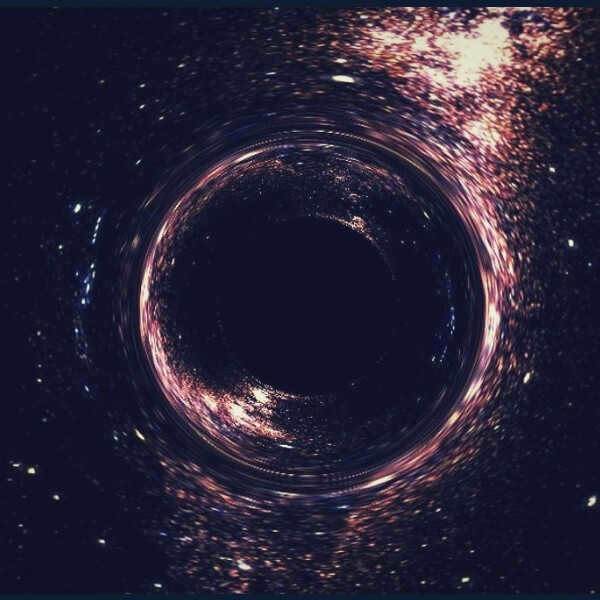
Therefore, the process of identifying Black Holes involves utilizing an indirect approach. When matter becomes entrapped within a Black Hole, it generates a spiral disk encircling the Black Hole itself. This disk consequently becomes intensely heated, leading to the emission of gamma rays and X-rays. By detecting these rays, we are able to locate the presence of black holes.
Summary
After gaining knowledge about the nature and life cycle of stars, it might appear that we have acquired complete understanding. However, our quest to answer the inquiry “What defines a star?” is far from complete. There is still a great deal more to explore.
The enigma of black holes





